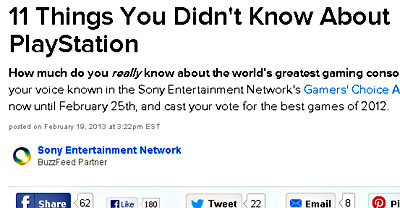Andrew Sullivan had a long, “passionate” debate at BuzzFeed last night about their habit of creating advertising content that’s hard to tell apart from editorial content. This is from an after-action report written this afternoon:
When an ad page is designed not even to be seen much on the site’s homepage — where the color shading helps maintain the distinction between ads and edit — and is deliberately purposed to be viral, to pop up alone on your screen with “Buzzfeed” at the top of the page and a layout identical to Buzzfeed’s, the deliberate attempt to deceive readers is impossible to miss.
Am I thinking readers are too dumb to notice the by-line? Aren’t they more sophisticated than that? No and yes, they’re sophisticated, but not the way an industry insider is.
Roger that. Here’s a little story that might shed some light on this. Several years ago, a friend of mine came over and noticed a three-ring binder sitting on my desk. It was full of stories clipped from the LA Times. “Why did you save these?” he asked. I told him to take  a closer look. “Do you notice anything similar about them?”
a closer look. “Do you notice anything similar about them?”
Nope. Finally I pointed at the bylines. They were all by me, written when I interned at the Times during college. The moral of the story is that people who don’t inhale news simply don’t notice bylines. They’re practically invisible. It’s possible this is different at BuzzFeed, where reporters develop a loyal following, but I doubt it. I’ll bet 90 percent of their readers never even notice their bylines.
And I’m pretty certain the folks at BuzzFeed know this perfectly well. They do everything they can to make advertising look staff-written, including in tone, style, and format, but leave themselves an out by putting corporate bylines on the ads and pretending that everyone will notice them. Hey, it says Sony Entertainment Network at the top! What more do you want?
I imagine this is a glimpse of our future. You have been warned.















